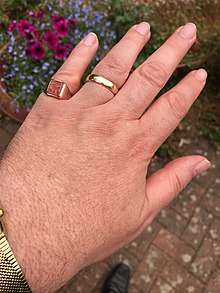Little finger
| Little finger | |
|---|---|
 Human little finger | |
| Details | |
| Artery |
Proper palmar digital arteries, dorsal digital arteries |
| Vein |
Palmar digital veins, dorsal digital veins |
| Nerve | Dorsal digital nerves of ulnar nerve |
| Lymph | supratrochlear |
| Identifiers | |
| Latin |
digitus minimus manus, digitus quintus manus, digitus V manus |
| TA | A01.1.00.057 |
| FMA | 24949 |
| Anatomical terminology | |
The little finger, or pinky finger (in American English), also known as the fifth digit, or pinkie, is the most ulnar and smallest finger of the human hand, opposite the thumb, and next to the ring finger.
Etymology
The word "pinky" is derived from the Dutch word pink, meaning "little finger". In some places "pinky" is also a traditional name for the smallest (youngest) child in a family (especially, when father and mother have 3 children).
The earliest recorded use of the term pinkie is in Scotland in 1808,[1]
Muscles
There are nine muscles that control the fifth digit: Three in the hypothenar eminence, two extrinsic flexors, two extrinsic extensors, and two more intrinsic muscles:
- Hypothenar eminence:
- Opponens digiti minimi muscle
- Abductor minimi digiti muscle (adduction from third palmar interossei)
- Flexor digiti minimi brevis (the "longus" is absent in most humans)
- Two extrinsic flexors:
- Two extrinsic extensors:
- Two intrinsic hand muscles:
- Fourth lumbrical muscle
- Third Palmar interosseous muscle
Note: the dorsal interossei of the hand muscles do not have an attachment to the fifth digit
Cultural significance
Gestures
Among American children, a "pinky swear" or "pinky promise" is made when a person wraps one of their pinky fingers around another person's pinky and makes a promise.[2]
Among members of the Japanese yakuza (gangsters), the penalty for various offenses is removal of parts of the little finger (known as yubitsume).[3]
In assorted cultures, some people extend their little finger when drinking from a teacup. This practice is generally deprecated by etiquette guides as a sign of snobbery amongst the socially inferior,[4][5] with various cultural theories as to the origin of the practice.[6]
Rings

The signet ring is traditionally worn on the little finger of a gentleman's left hand, a practice still common especially in the United Kingdom, Australia, and European cultures. A signet ring is considered part of the regalia of many European monarchies, and also of the Pope, with the ring always worn on the left little finger. In modern times the location of the signet ring has relaxed, with examples worn on various different fingers, although little fingers still tend to be the most usual.
The Iron Ring is a symbolic ring worn by most Canadian engineers. The Ring is a symbol of both pride and humility for the engineering profession, and is always worn on the pinky of the dominant hand. In the United States, the Engineer's Ring is a stainless steel ring worn on the fifth finger of the working hand by engineers who belong to the Order of the Engineer[7] and have accepted the Obligation of an Engineer.[8]
References
- ↑ "Pinkie". World Wide Words. Retrieved 25 July 2018.
- ↑ Roud, Steve. The Lore of the Playground. Random House. 2010.
- ↑ Hill, Peter B. E.: "The Japanese Mafia: Yakuza, law, and the state", p. 75. Oxford Univ. Press, 2003
- ↑ "Tea Etiquette". Tea Laden. Retrieved 28 July 2018.
- ↑ "Etiquette and History of Afternoon Tea". An Afternoon to Remember. Retrieved 28 July 2018.
- ↑ "Why do people extend their pinky finger when taking a drink from a glass?". Quora. Retrieved 28 July 2018.
- ↑ Engineer’s Ring, Order-of-the-engineer.org
- ↑ Obligation of an Engineer
See also
| Wikimedia Commons has media related to Pinky. |
- Fifth metacarpal bone - the bone in the hand proximal to the little finger
- Pinky ring
- Pinky swear - a type of oath involving the little finger
- Yubitsume - a Japanese ritual of apology by amputation of the little finger
- Red string of fate - a Japanese belief that soulmates are bound by a string attached to the little finger
| Look up little finger in Wiktionary, the free dictionary. |